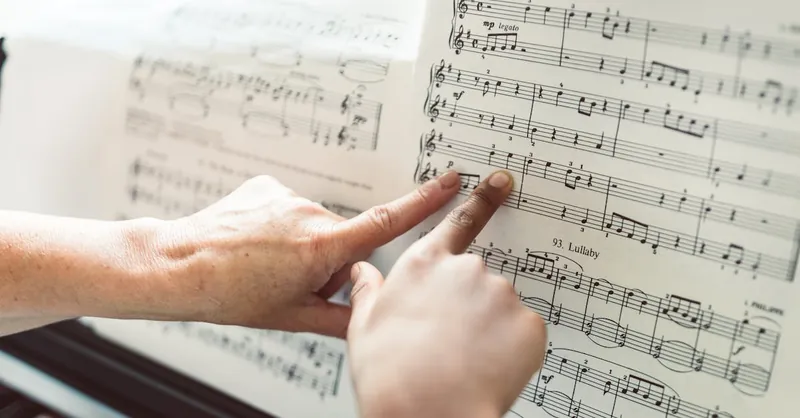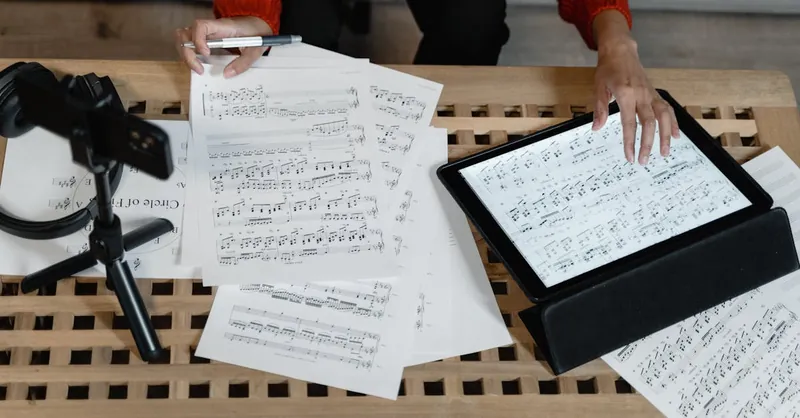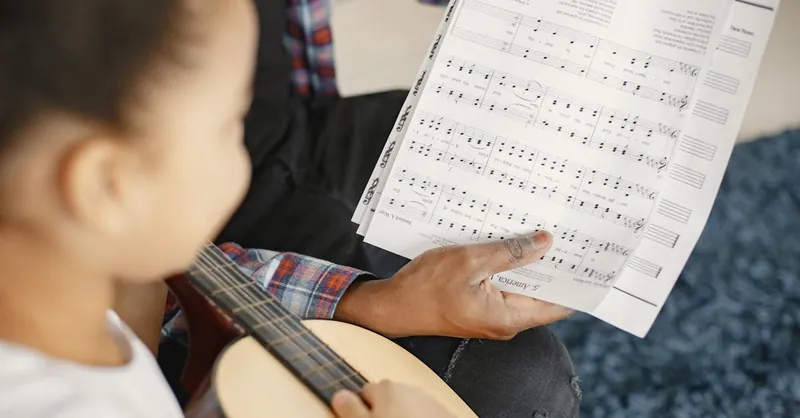Ear Training Tips for Guitar & Piano Beginners
Category: Music Theory
Master Ear Training for Guitar and Piano: A Beginner’s Guide
If you're a beginner musician working your way through guitar or piano tutorials, chances are you've encountered the challenge of improving your ear skills. Ear training is essential—it helps you recognize intervals, chords, and rhythms, making your playing more intuitive and musical. You’ve likely searched for clear, practical advice on how to develop this skill without drowning in complex theory. This guide is crafted just for you, focusing specifically on guitar and piano players who want straightforward ear training tips that fit their learning journey. We’re not here to overwhelm you with jargon but to give you actionable exercises and insights tailored to your instruments. Whether you struggle to identify chord progressions or find it tricky to pick out melodies by ear, this post breaks down effective strategies to boost your musical hearing step by step. By the end, you’ll understand not just how to train your ear, but why it matters in your playing and how you can practice efficiently alongside your guitar and piano lessons. Let’s unlock your musical potential with ear training techniques designed to make learning more fun, intuitive, and rewarding.
- Master Ear Training for Guitar and Piano: A Beginner’s Guide
- Understanding the Importance of Ear Training for Guitar and Piano Players: Benefits and Real-World Applications
- Basic Ear Training Concepts: Intervals, Scales, and Chord Recognition Explained Simply for Beginners
- Interval Recognition Exercises Tailored for Guitar and Piano: Practical Drills to Identify Intervals on Your Instrument
- Chord and Chord Progression Ear Training: How to Hear and Differentiate Common Chord Types and Sequences
- Rhythm and Timing Training: Developing a Steady Sense of Rhythm Through Clapping, Tapping, and Playing Exercises
- Using Technology and Apps Effectively: Recommended Ear Training Apps with Guitar and Piano Focus
- Integrating Ear Training with Your Daily Practice Routine: Tips for Consistent, Manageable Practice Sessions
- Advanced Listening Skills: Transcribing Simple Melodies and Solos by Ear for Guitar and Piano
- Common Challenges and How to Overcome Them: Motivation Tips, Dealing with Frustration, and Tracking Progress
- Resources for Continued Ear Training Growth: Books, Courses, and Online Communities Tailored for Beginners
Understanding the Importance of Ear Training for Guitar and Piano Players: Benefits and Real-World Applications
Developing strong ear training skills is crucial for every guitar and piano player, as it directly enhances your musicianship and overall musical experience. When you train your ear, you improve your ability to recognize chords, intervals, and rhythms instantly, which makes learning songs faster and playing by ear more accessible. For guitarists and pianists, this skill bridges the gap between theoretical knowledge and practical application, allowing you to connect what you see on the fretboard or keyboard with the sounds you hear.
Key Benefits of Ear Training for Guitar and Piano
-
Improved Musical Intuition
Ear training sharpens your instinct for melody and harmony. This means you’ll start to predict chord changes and melodic movements naturally, boosting your confidence during improvisation or jam sessions. -
Faster Learning and Transcription
By identifying notes and chords by ear, you can quickly learn new songs without relying solely on tablature or sheet music. This skill speeds up transcription and helps you internalize music more deeply. -
Better Rhythm and Timing
Ear training refines your sense of timing and rhythmic accuracy, which is vital for both solo practice and playing with other musicians. -
Enhanced Creativity and Improvisation
With a well-trained ear, you can experiment with new chord voicings, scales, and melodic ideas on both guitar and piano, leading to richer, more expressive performances.
Real-World Applications in Your Playing
- Song Learning: Quickly figure out unfamiliar songs by listening carefully and identifying chord progressions or riffs on guitar or piano.
- Improvisation: Use your ear to respond to backing tracks or live bandmates, creating spontaneous solos that fit the harmonic context perfectly.
- Ear-Based Composition: Compose melodies and harmonies by trusting your ear, without needing to write down every detail first.
- Music Collaboration: Communicate musical ideas effectively with other musicians, using shared understanding of intervals, chords, and rhythms.
By prioritizing ear training in your guitar and piano practice, you set yourself up for more intuitive playing and deeper musical understanding—key factors that separate good musicians from great ones. As you continue, you'll discover that ear training isn't just an exercise; it's the foundation for becoming a versatile, expressive player.

Image courtesy of Yan Krukau
Basic Ear Training Concepts: Intervals, Scales, and Chord Recognition Explained Simply for Beginners
To build a strong foundation in ear training for guitar and piano players, it’s essential to understand three core concepts: intervals, scales, and chord recognition. These elements form the building blocks of musical sound and help your ear identify and distinguish different pitches and harmonies.
Intervals: The Distance Between Two Notes
An interval is the pitch difference between two notes played either simultaneously or consecutively. Learning to recognize intervals by ear is key because intervals define the sound and character of melodies and chords. For beginners:
- Start with simple intervals like the perfect unison, major second, perfect fifth, and octave.
- Use familiar songs to memorize intervals—for example, the first two notes of Here Comes the Bride represent a perfect fourth.
- Practice distinguishing intervals both ascending and descending, as this will help with identifying melodies and chord tones on guitar and piano.
Scales: Patterns of Intervals That Form Melodies
A scale is a series of notes ordered by pitch, creating a specific sonic mood or color. For guitar and piano players, knowing common scales improves your ability to anticipate musical phrases and improvise. The most crucial scales to recognize aurally include:
- Major Scale: Bright and happy sounding; the foundation for Western music.
- Minor Scale: Sadder or more somber, important for emotional expression.
- Pentatonic Scale: Five-note scale widely used in rock, blues, and pop, useful for improvisation.
Practice singing or playing scales on your instrument while focusing on how they sound, training your ear to instinctively distinguish between major, minor, and pentatonic sounds.
Chord Recognition: Identifying Harmony by Ear
Chords are combinations of intervals, and recognizing them helps you understand song structure and harmony. For beginners, focus on:
- Major and Minor Chords: Learn the distinct “happy” or “sad” qualities.
- Seventh Chords: Add more color and tension, common in jazz and blues.
- Power Chords and Suspended Chords: Especially useful for guitar players in rock genres.
Use slow playback of songs or chord apps, and try to identify chord types by listening. Combining interval training with chord recognition exercises accelerates your ability to hear and reproduce chord progressions on both guitar and piano.
Mastering these basic ear training concepts will transform your musical listening and playing. Integrate interval drills, scale recognition, and chord identification into your daily practice routine to enhance your ear, making every guitar or piano session more productive and enjoyable.

Image courtesy of RDNE Stock project
Interval Recognition Exercises Tailored for Guitar and Piano: Practical Drills to Identify Intervals on Your Instrument
Mastering interval recognition is a cornerstone of effective ear training for both guitar and piano players. Intervals represent the foundational sound relationships between two notes, and being able to identify them quickly by ear transforms your ability to learn melodies, harmonies, and solos. To make these exercises practical, it’s best to use drills specifically designed around the unique layouts of your instrument—whether it's the fretboard of a guitar or the keyboard of a piano.
Interval Recognition Exercises for Guitar Players
On guitar, intervals are visual as well as auditory, since the fretboard offers a clear geometric layout. Use the following exercises to sharpen your interval ear:
-
Play and Name Intervals on One String
Focus on one string and play two notes consecutively, starting with unison, then moving to major seconds, thirds, perfect fifths, and octaves. Listen carefully to how the interval sounds, then try to sing or hum it before checking it again on the guitar. -
Interval Identification Across Strings
Move to intervals that span different strings and frets—for example, play the root on the 6th string and find the major third on the 5th string. This helps you connect interval sounds with common chord shapes and scale patterns. -
Use Backing Tracks or Apps with Interval Drills
Many ear training apps allow you to customize interval recognition exercises for guitarists. Try identifying intervals with these tools, then replicate them physically on your fretboard to strengthen the connection.
Interval Recognition Exercises for Piano Players
Piano players can benefit from the linear, visual pattern of the keyboard to associate intervals with specific keys:
-
Play Intervals Up and Down
Start by playing two notes together (harmonic intervals) then separately (melodic intervals), such as C and E for a major third. Play both ascending and descending intervals to develop a well-rounded ear. -
Sing Intervals While Playing
Singing intervals as you play them on the keyboard reinforces auditory memory. For instance, play a perfect fifth, then sing the interval name and notes out loud to integrate your ear and voice. -
Interval Recognition in Different Keys
Practice intervals in various keys, not just C major. This prevents your ear from solely relying on a familiar tonal center and adapts your hearing to diverse tonal contexts.
Why These Interval Exercises Work for Both Instruments
- Contextual Learning: These exercises integrate visual, tactile, and auditory senses, making recognition faster.
- Progressive Difficulty: Starting with simple intervals and gradually increasing complexity builds confidence and skill.
- Real-World Application: Knowing intervals by ear helps you anticipate chord tones, create solos, and better understand music theory in practice.
Integrate these interval drills regularly into your guitar or piano routine. Over time, you’ll find that identifying intervals becomes effortless, enhancing your overall musicianship and accelerating your progress on your chosen instrument.

Image courtesy of Yan Krukau
Chord and Chord Progression Ear Training: How to Hear and Differentiate Common Chord Types and Sequences
Developing the ability to recognize chords and chord progressions by ear is a critical step for guitar and piano players seeking greater musical fluency. Unlike single-note interval training, chord ear training involves identifying multiple notes sounding together or in quick succession, which deepens your understanding of harmony and song structure.
Recognizing Common Chord Types by Ear
Start by focusing on the most frequently used chord types and their distinct sonic qualities:
- Major Chords: Bright, stable, and “happy” sounding. Typical example: C major.
- Minor Chords: Darker or sadder tone, created by lowering the third degree of the major chord. Example: A minor.
- Dominant Seventh (7) Chords: Add tension and a bluesy feel, often resolving to a major chord. Example: G7.
- Major Seventh and Minor Seventh Chords: Softer and jazzy, with a smooth, relaxed sound.
- Suspended (sus2 and sus4) Chords: Lack the third, creating a suspended or unresolved tension.
- Power Chords: Root and fifth only, common in rock and simpler textures, recognizable by their open sound.
Practice identifying these chords by listening to recordings or using ear training apps that play and quiz each chord type. On guitar and piano, try playing these chords yourself to associate the physical feel with their sound and emotional character.
Training to Hear Chord Progressions
Chord progressions—the sequences in which chords change—form the backbone of most songs. Learning to hear these movements can dramatically improve your ability to play by ear and compose.
- Start with simple progressions:
- I-IV-V (e.g., C–F–G): The most common and fundamental progression in Western music.
- ii-V-I: Essential in jazz and pop styles.
-
vi-IV-I-V: Used widely in pop and rock music.
-
Listen actively to songs you know, identifying how chords move from one to another. Play along on your guitar or piano, trying to match the chords by ear.
-
Deconstruct progressions by focusing on bass notes and chord qualities. The bass often outlines the root motion, which is a strong clue for identifying what chords are playing.
-
Use call-and-response exercises: Have someone play or sing a chord progression, then replicate it by ear on your instrument. This strengthens your auditory memory and practical application.
Mastering chord and progression ear training empowers you to intuitively understand the harmonic context of any piece, enhancing your improvisation, songwriting, and overall musicianship on both guitar and piano. Consistent practice in distinguishing chords and progressions will unlock new dimensions in your playing and deepen your connection to music.

Image courtesy of Pavel Danilyuk
Rhythm and Timing Training: Developing a Steady Sense of Rhythm Through Clapping, Tapping, and Playing Exercises
A strong sense of rhythm and timing is fundamental for guitar and piano players, as it anchors your playing and makes your music feel cohesive and expressive. While recognizing pitches and chords is vital, mastering rhythm training ensures that your musical ideas flow smoothly and stay locked in with other musicians or backing tracks. Developing this skill requires focused exercises that integrate listening, physical movement, and instrumental practice.
Why Rhythm and Timing Matter for Guitar and Piano Players
Rhythm governs when notes and chords are played, shaping the groove and feel of any piece. For guitarists, precise timing is critical for strumming patterns, fingerpicking, and rhythmic riffs. Pianists rely on rhythmic accuracy to sync hands, support melodic phrasing, and interact with other instruments. Improving rhythm enhances your ability to play:
- In time with a metronome or band
- Complex syncopated patterns and grooves
- Dynamic accents and rests for musical expression
Effective Rhythm and Timing Exercises
To develop a consistent rhythmic foundation, incorporate these beginner-friendly exercises into your practice routine:
- Clapping and Tapping Exercises
- Start by clapping simple quarter-note and eighth-note rhythms along with a metronome.
- Progress to more complex patterns involving syncopation or triplets to challenge your internal pulse.
-
Tap out rhythms on your desk or thigh to connect physical movement to sound.
-
Subdivision Practice
- Break down beats into smaller subdivisions (e.g., dividing a beat into 2, 3, or 4 parts).
-
Practice counting out loud while playing or tapping, which builds strong internal timing.
-
Playing Rhythmic Patterns on Your Instrument
- For guitar, strum or pluck notes in rhythm using a metronome, starting with basic downbeats before adding upstrokes and rests.
-
For piano, play chord stabs or repeated note patterns focusing on tight synchronization with a steady tempo.
-
Use Backing Tracks and Loopers
- Jam along with metronome-backed drum loops or backing tracks to simulate real playing environments, reinforcing your timing in musical contexts.
By regularly practicing these rhythm and timing drills, you enhance your ability to internalize pulse, maintain steady tempo, and execute complex rhythmic figures. This training complements your ear skills by making rhythm recognition and reproduction second nature, ultimately making your guitar and piano performances more polished and engaging.

Image courtesy of Ketut Subiyanto
Using Technology and Apps Effectively: Recommended Ear Training Apps with Guitar and Piano Focus
In today’s digital age, leveraging technology is one of the most effective ways to accelerate your ear training progress for both guitar and piano. Dedicated ear training apps offer interactive, customizable exercises that align perfectly with your learning pace and instrument-specific needs. These tools provide immediate feedback, making practice sessions more productive and engaging compared to traditional methods alone.
Top Ear Training Apps for Guitar and Piano Players
-
Tenuto
This highly versatile app covers interval recognition, chord identification, scale training, and rhythmic exercises. Its clear interface allows you to customize drills, making it ideal for guitarists and pianists wanting focused practice on intervals, chords, and sight singing. -
Perfect Ear
Perfect Ear stands out for its broad range of exercises including interval, chord, and scale identification plus rhythm training. It features adjustable difficulty levels and allows you to practice recognizing guitar chords and piano harmonies with real instrument sounds. -
EarMaster
EarMaster offers an extensive library of ear training tasks complemented by guitar and piano-specific modules. Its chord progression ear training and singing exercises build confident aural skills—crucial for playing and composing by ear. The app also supports MIDI keyboard input, which piano players will find highly beneficial. -
Functional Ear Trainer
Focused on relative pitch and functional hearing, this app helps beginners understand how notes relate in a key—a vital skill for improvisation and transcribing music on guitar and piano. The interactive lessons promote active listening and internalization of tonal relationships. -
Chordify
While not a traditional ear training app, Chordify is excellent for identifying chords and progressions in songs you love. By displaying chord diagrams for guitar and piano in real time, it encourages practical application of what you train aurally.
How to Maximize Ear Training App Use
- Set Clear Goals: Determine whether you want to focus on intervals, chords, rhythms, or all three, then select exercises that match those goals.
- Practice Regularly in Short Sessions: Consistency is key; use apps for 10–15 minutes daily rather than sporadic, long sessions.
- Combine App Practice with Instrument Play: After identifying intervals or chords using an app, immediately replicate them on your guitar or piano. This deepens the mind-hand-ear connection essential for musicianship.
- Use Real Instrument Sounds: Choose apps with high-quality guitar and piano samples to familiarize your ear with the actual tones you’ll encounter while playing.
Integrating technology-driven ear training into your practice routine transforms abstract listening exercises into concrete musical skills that directly enhance your guitar and piano playing abilities. By using these recommended apps thoughtfully, you’ll fast-track your ear development and enjoy more confident, intuitive performances.

Image courtesy of Tima Miroshnichenko
Integrating Ear Training with Your Daily Practice Routine: Tips for Consistent, Manageable Practice Sessions
Building strong ear training skills requires consistency and a structured approach that fits seamlessly into your existing guitar or piano practice routine. To avoid burnout and maximize progress, focus on short, regular practice sessions rather than infrequent, lengthy ones. Even just 10 to 15 minutes daily dedicated specifically to ear training can significantly improve your ability to recognize intervals, chords, rhythms, and melodies over time.
Effective Strategies for Daily Ear Training Integration
-
Combine Ear Training with Instrument Practice
Make your ear exercises practical by applying what you hear directly on your guitar or piano. After identifying an interval or chord through listening drills or apps, immediately play it on your instrument to reinforce the connection between your ear and your hands. -
Set Specific, Measurable Goals
Focus each session on a particular ear training skill, such as interval recognition one day and chord progression identification the next. This targeted approach prevents overwhelm and ensures balanced skill development. -
Incorporate Listening and Active Analysis
Use moments of passive listening to actively analyze music. For example, while listening to your favorite songs, try to pick out chord changes, interval leaps, or rhythmic patterns. This strengthens your ability to train your ear in real-world musical contexts. -
Utilize Technology as a Complement, Not a Crutch
Apps and software are powerful tools when integrated thoughtfully. Use them to guide practice, track progress, and keep exercises fresh, but always follow up by replicating sounds on your guitar or piano to solidify learning. -
Keep Sessions Manageable and Enjoyable
Avoid forcing yourself through tedious drills. Instead, vary exercises, include singing intervals aloud, and practice with backing tracks or jam along with simple songs to keep your ear training engaging and motivating.
By weaving these practical tips into your daily practice, ear training becomes a natural, focused habit that steadily enhances your musical intuition and skill on guitar and piano. This consistent, manageable practice is the key to transforming passive listening into active musicianship, ultimately enabling you to learn faster, improvise confidently, and play more expressively.

Image courtesy of Yan Krukau
Advanced Listening Skills: Transcribing Simple Melodies and Solos by Ear for Guitar and Piano
Once you have a solid grasp of the fundamentals—intervals, chords, rhythm, and basic ear training—it’s time to elevate your skills by transcribing melodies and solos by ear. Transcription is a powerful advanced ear training technique that challenges your ability to hear, analyze, and replicate music without relying on sheet music or tabs. This practice is especially beneficial for guitar and piano players who want to internalize phrasing, develop musical memory, and improve improvisational skills.
Why Transcribing Melodies and Solos Boosts Your Musicianship
- Deepens Aural Understanding: By carefully listening to music and dissecting melodies or solos, you train your brain to identify subtle pitch changes, rhythmic nuances, and expressive techniques unique to guitar or piano.
- Improves Musical Vocabulary: Learning phrases directly from recordings expands your repertoire of licks, motifs, and chord voicings in a meaningful context.
- Connects Theory to Practice: Transcribing bridges theoretical knowledge with real-world sound, making scales, intervals, and chords more intuitive as you match what you hear to your instrument.
- Enhances Memory and Focus: The concentration needed to transcribe sharpens your overall listening skills, helping you recognize patterns quicker in future learning.
Practical Tips for Effective Transcription by Ear
-
Choose Simple Melodies or Solos
Start with clear, slow pieces—think folk tunes, basic blues licks, or beginner-friendly piano melodies. Avoid overly complex jazz solos or fast shredding at the outset. -
Work in Small Sections
Divide the melody into short phrases (2–4 measures). Loop each segment repeatedly until you can hum, sing, or play it accurately by ear on your guitar or piano. -
Use Slowdown Tools and Looping Features
Software like Transcribe!, Amazing Slow Downer, or YouTube’s playback speed settings help you catch tricky notes and rhythms without losing musical context. -
Hum or Sing Before Playing
Vocalizing the melody reinforces pitch accuracy and rhythm before transferring the sounds to your instrument, creating an internalized sonic map. -
Write It Down or Tab It Out
Documenting what you hear using standard notation or tablature solidifies your understanding and creates a personal reference for practice. -
Verify with Your Instrument
Constantly check your transcriptions by playing them on guitar or piano, adjusting notes until your version matches the recording perfectly.
By integrating transcription practice into your ear training routine, you cultivate advanced listening skills essential for playing naturally by ear, improvising confidently, and immersing yourself deeply in the musical language of guitar and piano. This process transforms passive listening into active musicianship, setting you on the path toward mastering your favorite melodies and solos with greater ease and authenticity.

Image courtesy of Gustavo Fring
Common Challenges and How to Overcome Them: Motivation Tips, Dealing with Frustration, and Tracking Progress
Embarking on an ear training journey for guitar and piano can be immensely rewarding, but it often comes with its share of challenges. Many beginners struggle with staying motivated, feel frustrated by slow progress, or lose track of their improvements over time. Recognizing these common hurdles and implementing practical solutions is key to maintaining a consistent practice routine and ensuring continuous growth in your ear training skills.
Staying Motivated Through the Learning Curve
Ear training is a gradual process that requires patience and persistence. To keep yourself motivated:
- Set Clear, Achievable Goals: Break down your ear training into small, focused milestones, such as mastering interval recognition or identifying simple chord progressions within a set timeframe.
- Celebrate Small Wins: Acknowledge and reward your progress regularly, whether it’s correctly identifying a tricky interval or transcribing a simple melody by ear.
- Incorporate Enjoyable Materials: Use songs you love or familiar pieces in your exercises; this makes ear training feel more relevant and fun rather than a chore.
- Vary Your Practice Routine: Mix intervals, chords, rhythm exercises, and singing to keep sessions engaging and avoid monotony.
Effectively Dealing with Frustration and Plateaus
Frustration often arises when progress seems slow or when specific ear training concepts feel elusive. To overcome these obstacles:
- Take Breaks When Needed: Brief pauses can refresh your mind and prevent burnout.
- Return to Fundamentals: Revisiting basic intervals or rhythm drills can rebuild confidence and reinforce a solid foundation.
- Use Supportive Tools: Leverage apps and backing tracks to provide immediate feedback and structured learning pathways.
- Practice Mindfully: Focus on quality over quantity; attentive, relaxed practice is more effective than repetitive, distracted sessions.
Tracking Progress for Long-Term Success
Monitoring your ear training development not only boosts motivation but provides valuable insights into your strengths and areas for improvement:
- Keep a Practice Journal: Log the exercises you do, the time spent, and any breakthroughs or difficulties you encounter.
- Record Yourself: Playing back recordings of your practice sessions helps objectively assess your accuracy and musicality.
- Periodically Reassess Skills: Use ear training apps’ built-in tests or self-administered quizzes to measure interval, chord, and rhythm recognition improvements.
- Set Progressive Challenges: As you improve, increase the difficulty of exercises to continually develop your skills.
By addressing motivation challenges, managing frustration constructively, and systematically tracking progress, you position yourself for consistent ear training success. These strategies transform what can seem like a daunting process into a manageable, rewarding part of your guitar and piano practice that steadily enhances your musical intuition and confidence.

Image courtesy of Yan Krukau
Resources for Continued Ear Training Growth: Books, Courses, and Online Communities Tailored for Beginners
As you advance in your ear training journey for guitar and piano, tapping into high-quality resources designed for beginners can significantly boost your progress and keep your practice fresh and inspiring. Whether you prefer self-paced books, structured online courses, or engaging communities, there are numerous options tailored to help you develop your aural skills effectively and enjoyably.
Recommended Books for Ear Training Beginners
-
“Ear Training for the Contemporary Musician” by Keith Wyatt and Carl Schroeder
This book offers clear explanations and practical exercises that build fundamental ear training skills. Its focus on contemporary genres and inclusion of guitar and piano examples make it especially relevant for beginner instrumentalists. -
“A New Approach to Ear Training” by Leo Kraft
Ideal for beginners, this classic resource breaks down ear training concepts into manageable lessons, emphasizing intervals, rhythms, and melody recognition. It’s a trusted staple in many music education programs. -
“Practical Ear Training” by Matthew Harris
Structured progressively, this book combines theory with exercises that develop real-world listening skills. It includes sections specifically designed to help guitarists and pianists connect aural recognition with their instruments.
Online Courses and Platforms to Accelerate Ear Training
-
Berklee Online’s Ear Training Courses
Berklee offers beginner-friendly ear training courses that combine video lessons with interactive drills ideal for guitar and piano players. The curriculum focuses on intervals, chords, scale recognition, and rhythm. -
Udemy’s Ear Training for Guitarists and Pianists
These courses provide structured training with practical exercises and demonstrations tailored to your instrument. They often come with lifetime access and community support. -
Coursera’s Developing Your Musicianship by Berklee College of Music
A foundational course that includes comprehensive ear training modules, helping you build listening skills alongside music theory fundamentals.
Thriving Online Communities for Peer Learning and Support
-
Reddit's r/musictheory and r/guitar and r/piano
These subreddits offer beginner-friendly discussions, weekly challenges, and resources. You can ask questions about ear training exercises, share progress, and find motivation from fellow learners. -
ToneGym
An interactive web-platform combining ear training gamification with social features, allowing musicians to compete, collaborate, and track progress in a community focused on improving listening skills. -
Music Stack Exchange
A valuable forum for detailed questions related to ear training on guitar and piano, where experienced musicians and educators provide insightful answers.
How to Choose the Right Resources for Your Ear Training Growth
- Match the Resource with Your Learning Style: If you prefer self-study, books and apps may work best. For guided learning, opt for online courses with structured feedback.
- Look for Instrument-Specific Content: Prioritize materials that address the guitar or piano directly, as this helps translate ear training into practical playing skills.
- Engage Regularly with Communities: Sharing your challenges and successes with other learners encourages accountability and exposes you to diverse learning tips and techniques.
By leveraging these carefully selected ear training books, courses, and online communities, beginner guitar and piano players can sustain steady growth in their aural abilities. These resources provide the structured guidance, motivation, and real-world application necessary to develop a confident, musical ear that will transform your playing and deepen your understanding of music theory.

Image courtesy of cottonbro studio
